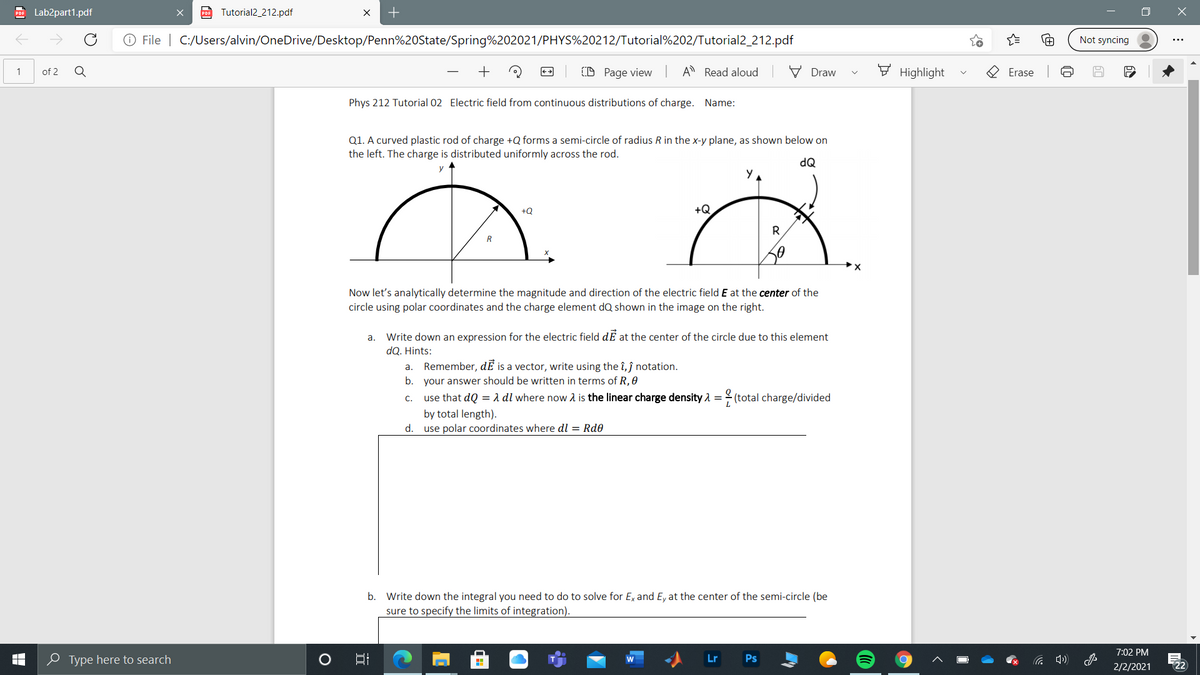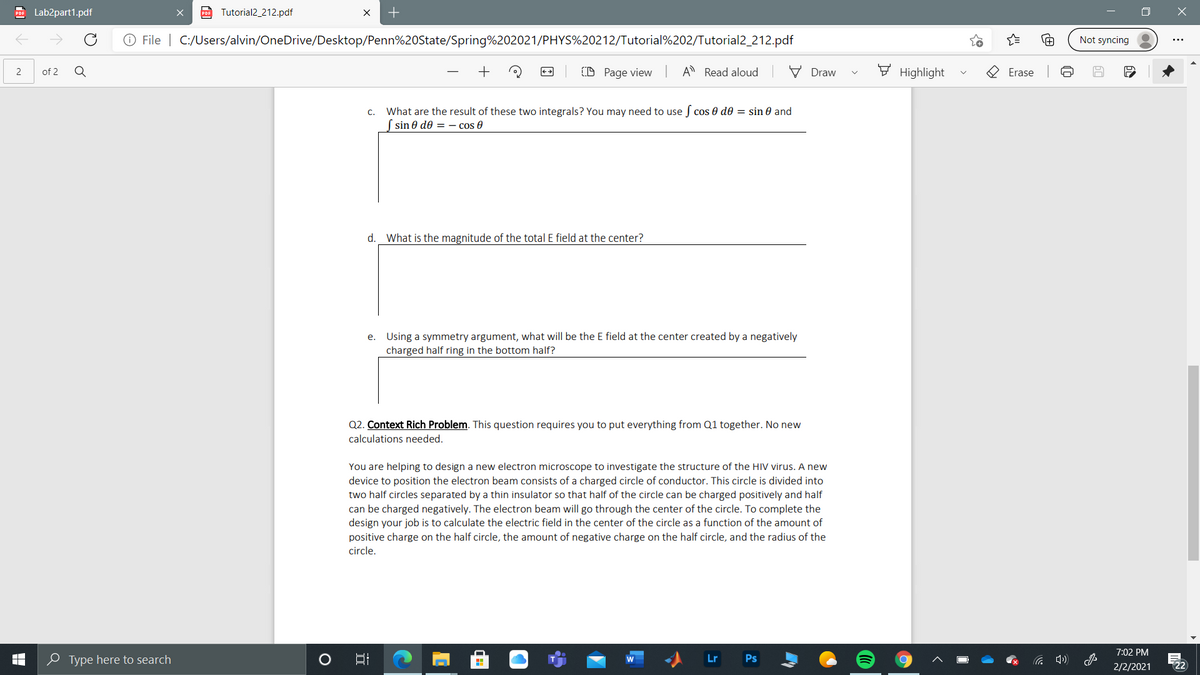Q1. A curved plastic rod of charge +Q forms a semi-circle of radius R in the x-y plane, as shown below on the left. The charge is distributed uniformly across the rod. dQ Now let's analytically determine the magnitude and direction of the electric field E at the center of the circle using polar coordinates and the charge element dQ shown in the image on the right.
Q1. A curved plastic rod of charge +Q forms a semi-circle of radius R in the x-y plane, as shown below on the left. The charge is distributed uniformly across the rod. dQ Now let's analytically determine the magnitude and direction of the electric field E at the center of the circle using polar coordinates and the charge element dQ shown in the image on the right.
Chapter7: Electricity
Section: Chapter Questions
Problem 2Q
Related questions
Question

Transcribed Image Text:PO Lab2part1.pdf
po Tutorial2_212.pdf
O File | C:/Users/alvin/OneDrive/Desktop/Penn%20State/Spring%202021/PHYS%20212/Tutorial%202/Tutorial2_212.pdf
Not syncing
of 2
+
(D Page view
A Read aloud
V Draw
F Highlight
1
Erase
Phys 212 Tutorial 02 Electric field from continuous distributions of charge. Name:
Q1. A curved plastic rod of charge +Q forms a semi-circle of radius R in the x-y plane, as shown below on
the left. The charge is distributed uniformly across the rod.
dQ
+Q
+Q
R
Now let's analytically determine the magnitude and direction of the electric field E at the center of the
circle using polar coordinates and the charge element dQ shown in the image on the right.
Write down an expression for the electric field dE at the center of the circle due to this element
dQ. Hints:
a. Remember, dE is a vector, write using the î, ĵ notation.
b. your answer should be written in terms of R, 0
a.
c.
use that dQ = a dl where now 2 is the linear charge density 1 = 2 (total charge/divided
by total length).
d. use polar coordinates where dl = Rd0
b. Write down the integral you need to do to solve for Ex and E, at the center of the semi-circle (be
sure to specify the limits of integration).
7:02 PM
e Type here to search
口
Lr
Ps
2/2/2021
22ת

Transcribed Image Text:PO Lab2part1.pdf
po Tutorial2_212.pdf
O File | C:/Users/alvin/OneDrive/Desktop/Penn%20State/Spring%202021/PHYS%20212/Tutorial%202/Tutorial2_212.pdf
Not syncing
of 2
+
(D Page view
A Read aloud
V Draw
F Highlight
2
Erase
What are the result of these two integrals? You may need to use f cos 0 d0 = sin 0 and
| sin 0 de = - cos 0
C.
d.
What is the magnitude of the total E field at the center?
e. Using a symmetry argument, what will be the E field at the center created by a negatively
charged half ring in the bottom half?
Q2. Context Rich Problem. This question requires you to put everything from Q1 together. No new
calculations needed.
You are helping to design a new electron microscope to investigate the structure of the HIV virus. A new
device to position the electron beam consists of a charged circle of conductor. This circle is divided into
two half circles separated by a thin insulator so that half of the circle can be charged positively and half
can be charged negatively. The electron beam will go through the center of the circle. To complete the
design your job is to calculate the electric field in the center of the circle as a function of the amount of
positive charge on the half circle, the amount of negative charge on the half circle, and the radius of the
circle.
7:02 PM
e Type here to search
Lr
Ps
2/2/2021
22ת
Expert Solution
This question has been solved!
Explore an expertly crafted, step-by-step solution for a thorough understanding of key concepts.
This is a popular solution!
Trending now
This is a popular solution!
Step by step
Solved in 2 steps with 8 images

Knowledge Booster
Learn more about
Need a deep-dive on the concept behind this application? Look no further. Learn more about this topic, physics and related others by exploring similar questions and additional content below.Recommended textbooks for you


College Physics
Physics
ISBN:
9781938168000
Author:
Paul Peter Urone, Roger Hinrichs
Publisher:
OpenStax College

Physics for Scientists and Engineers: Foundations…
Physics
ISBN:
9781133939146
Author:
Katz, Debora M.
Publisher:
Cengage Learning


College Physics
Physics
ISBN:
9781938168000
Author:
Paul Peter Urone, Roger Hinrichs
Publisher:
OpenStax College

Physics for Scientists and Engineers: Foundations…
Physics
ISBN:
9781133939146
Author:
Katz, Debora M.
Publisher:
Cengage Learning

College Physics
Physics
ISBN:
9781285737027
Author:
Raymond A. Serway, Chris Vuille
Publisher:
Cengage Learning

Principles of Physics: A Calculus-Based Text
Physics
ISBN:
9781133104261
Author:
Raymond A. Serway, John W. Jewett
Publisher:
Cengage Learning
